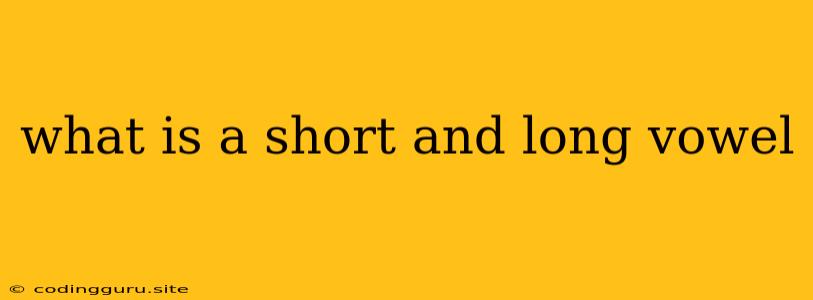What are Short and Long Vowels?
Vowels are the building blocks of words, and they can be pronounced in different ways, creating unique sounds. Short vowels and long vowels are two fundamental concepts in the English language that define how we pronounce vowels in words.
What are Short Vowels?
Short vowels are pronounced quickly and with a short, sharp sound. They are typically found in words with one syllable. Imagine saying the letter name of the vowel quickly and concisely – that's how a short vowel sounds!
Here's a table illustrating short vowels and their common spellings:
| Short Vowel | Sound | Example |
|---|---|---|
| a | /æ/ | cat, map, bat |
| e | /ɛ/ | bed, ten, get |
| i | /ɪ/ | pig, sit, win |
| o | /ɑ/ | hot, top, dog |
| u | /ʌ/ | cup, sun, fun |
What are Long Vowels?
Long vowels are pronounced with a longer, more drawn-out sound. They are typically found in words with two syllables or when a vowel is followed by a silent "e" at the end of a word.
Here's a table illustrating long vowels and their common spellings:
| Long Vowel | Sound | Example |
|---|---|---|
| a | /eɪ/ | cake, name, rain |
| e | /iː/ | bee, tree, see |
| i | /aɪ/ | bike, time, like |
| o | /oʊ/ | boat, go, toe |
| u | /uː/ | flute, tune, rule |
How to Identify Short and Long Vowels:
- Listen for the sound: Pay close attention to how the vowel sound is pronounced in a word. Is it quick and sharp (short) or long and drawn out (long)?
- Look for the spelling: Short vowels are often found in one-syllable words or words with vowel combinations. Long vowels are often found in words with two syllables or words ending in a silent "e".
- Use your knowledge of phonics: Phonics is the understanding of the relationship between letters and sounds. Learning about phonics rules will help you predict whether a vowel will be short or long.
Why are Short and Long Vowels Important?
Understanding the difference between short and long vowels is essential for:
- Reading Fluency: Recognizing the different vowel sounds helps you read words more quickly and accurately.
- Spelling: Knowing when to use different spellings for vowel sounds improves your spelling accuracy.
- Pronouncing Words Correctly: Correct pronunciation is crucial for effective communication.
- Understanding the Meaning of Words: Different vowel sounds can change the meaning of a word, for example, "bat" vs. "bait".
Conclusion
Learning about short and long vowels is a fundamental step in mastering the English language. By understanding how vowels are pronounced and spelled, you can improve your reading, writing, and communication skills. Practice identifying the sounds and spellings of short and long vowels in words, and soon you will be confidently navigating the world of vowel sounds!
